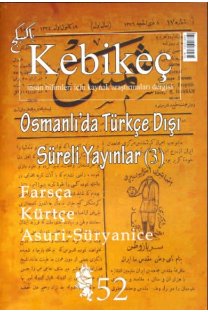Modern İnsan Popülasyonlarında Arkaik İzler
___
Abi-Rached, L. et al., "The shaping of modern human immune systems by multiregional admixture with archaic humans", Science 334, 89-94 (2011).Beall, C. M. et al., "Hemoglobin concentration of high-altitude Tibetans and Bolivian Aymara", Am. J. Phys. Anthropol. 106, 385-400 (1998).
Birney, E. & Soranzo, N., "Human genomics: The end of the start for population sequencing", Nature 526, 52-53 (2015).
Cann, R. L., Stoneking, M. & Wilson, A. C., "Mitochondrial DNA and human evolution", Nature 325, 31-6 (1987).
Consortium, 1000 Genomes Project et al. "A map of human genome variation from population-scale sequencing", Nature 467, 1061-1073 (2010).
Currat, M. & Excoffier, L., "Modern humans did not admix with Neanderthals during their range expansion into Europe", PLoS Biol. 2, e421 (2004).
Dannemann, M., Andrés, A. M. & Kelso, J., "Introgression of Neandertal- and Denisovan- like Haplotypes Contributes to Adaptive Variation in Human Toll-like Receptors", Am.
Sankararaman, S. et al. "The genomic landscape of Neanderthal ancestry in present-dayhumans", Nature 507, 354-7 (2014).
Racimo, F., Sankararaman, S., Nielsen, R. & Huerta-Sánchez, E., "Evidence for archaic adaptive introgression in humans", Nat. Rev. Genet. 16, 359-71 (2015). J. Hum. Genet. 98, 22-33 (2016).
Deschamps, M. et al., "Genomic Signatures of Selective Pressures and Introgression from Archaic Hominins at Human Innate Immunity Genes", Am. J. Hum. Genet. 98, 5-21 (2016).
Flegontov, P. et al., "Genomic study of the Ket: a Paleo-Eskimo-related ethnic group with significant ancient North Eurasian ancestry", Sci. Rep. 6, 20768 (2016).
Green, R. E. et al., "A Draft Sequence of the Neandertal Genome", Science (80-. ). 328, 710- 722 (2010).
Haak, W. et al., "Massive migration from the steppe was a source for Indo-European languages in Europe", Nature 522, 207-211 (2015).
Hartl, D. L. & Clark, A. G., Principles of Population Genetics. (Sinauer Associates, 2007).
Huerta-Sánchez, E. et al., "Altitude adaptation in Tibetans caused by introgression of Denisovan-like DNA", Nature 512, 194-7 (2014).
Jobling, M., Hollox, E., Hurles, M., Kivisild, T. & Tyler-Smith, C., Human Evolutionary Genetics: Origins, Peoples & Disease. (Garland Science, 2014).
Khrameeva, E. E. et al., "Neanderthal ancestry drives evolution of lipid catabolism in contemporary Europeans", Nat. Commun. 5, 3584 (2014).
Krings, M. et al., "Neandertal DNA Sequences and the Origin of Modern Humans", Cell 90, 19-30 (1997).
Kuhlwilm, M. et al., "Ancient gene flow from early modern humans into Eastern Neanderthals", Nature 530, 429-433 (2016).
Mendez, F. L., Watkins, J. C. & Hammer, M. F., "A haplotype at STAT2 Introgressed from neanderthals and serves as a candidate of positive selection in Papua New Guinea", Am. J. Hum. Genet. 91, 265-74 (2012).
Millennium Ecosystem Assessment. Ecosystems and Human Well-being: Biodiversity Synthesis. Ecosystems 86, (2005).
Racimo, F., Sankararaman, S., Nielsen, R. & Huerta-Sánchez, E., "Evidence for archaic adaptive introgression in humans", Nat. Rev. Genet. 16, 359-71 (2015).
Reich, D. et al., "Genetic history of an archaic hominin group from Denisova Cave in Siberia", Nature 468, 1053-60 (2010).
Reich, D. et al., "Denisova Admixture and the First Modern Human Dispersals into Southeast Asia and Oceania", Am. J. Hum. Genet. 89, 516-528 (2011).
Sankararaman, S. et al., "The genomic landscape of Neanderthal ancestry in present-day humans", Nature 507, 354-7 (2014).
Sawyer, S. et al., "Nuclear and mitochondrial DNA sequences from two Denisovan individuals", Proc. Natl. Acad. Sci. (2015). doi:10.1073/pnas.1519905112
Schiffels, S. et al., "Iron Age and Anglo-Saxon genomes from East England reveal British migration history", Nat. Commun. 7, 10408 (2016).
Skoglund, P. et al., "Genetic evidence for two founding populations of the Americas", Nature 525, 104-110 (2015).
Templeton, A., "Out of Africa again and again", Nature 416, 45-51 (2002).
Vernot, B. et al., "Excavating Neandertal and Denisovan DNA from the genomes of Melanesian individuals", Science (80-. ). 352, 235-239 (2016).
- ISSN: 1300-2864
- Yayın Aralığı: 2
- Başlangıç: 1995
- Yayıncı: Mehtap Yüksel
Osmanlı'da İnsanın Kökeni ve Evrimine Dair Tartışmalar
Bir "Kırk Kere Söylersen Gerçek Olur" Vakası Olarak "Dini Islah Beyannamesi" ve "Gerçeğin" Kaynağı
Evrimsel Tıp: Sağlık ve Hastalıklara Yeni Yaklaşımlar
20. Yüzyılın Başında İstanbul Limanı: Hamallar Dersaadet Rıhtım Şirketi ve Osmanlı Hükümeti
"Hasta Adam" Ülkesindeki Küçük Kuzenimiz
Çevresel ve Paleoiklimsel Faktörlerin Etkisinde Doğu Afrika'da İnsanın Evrimi
